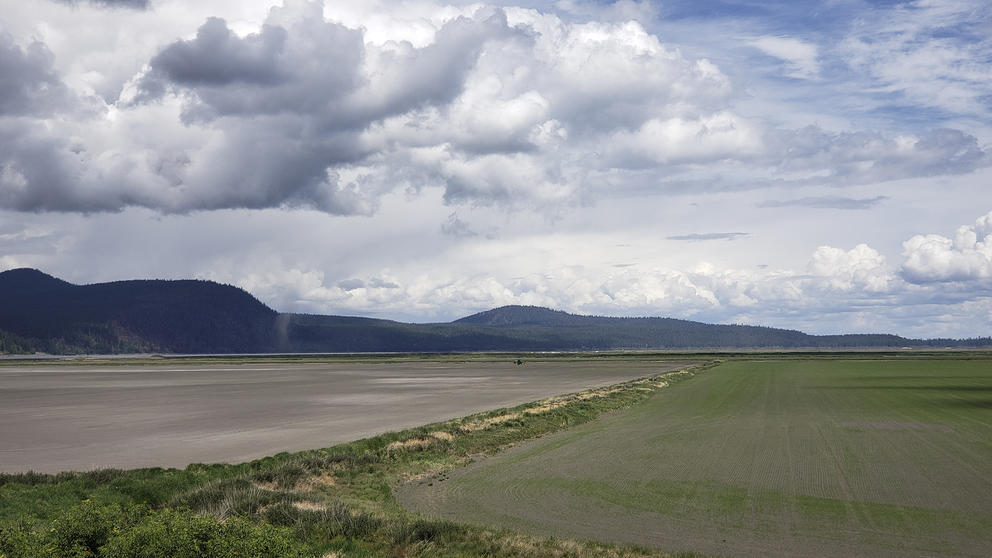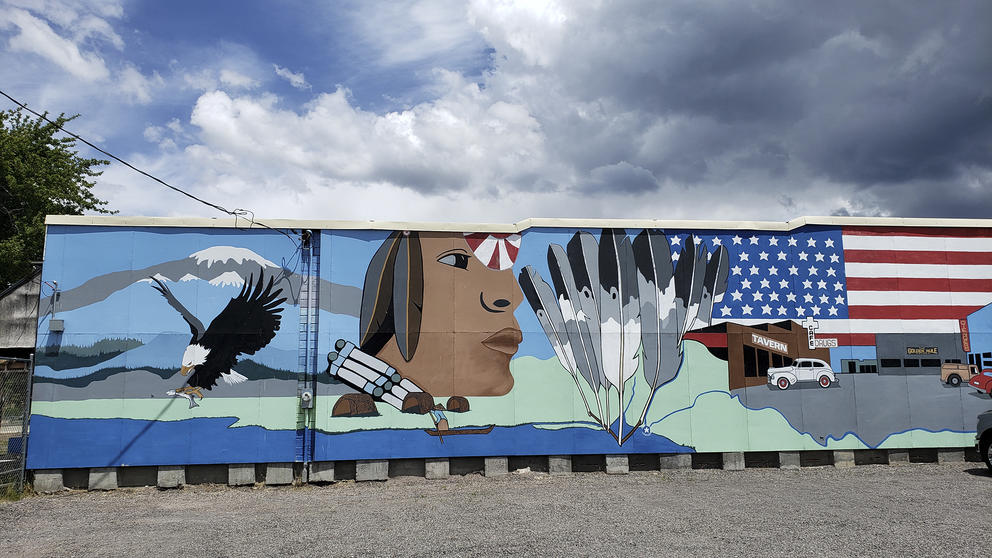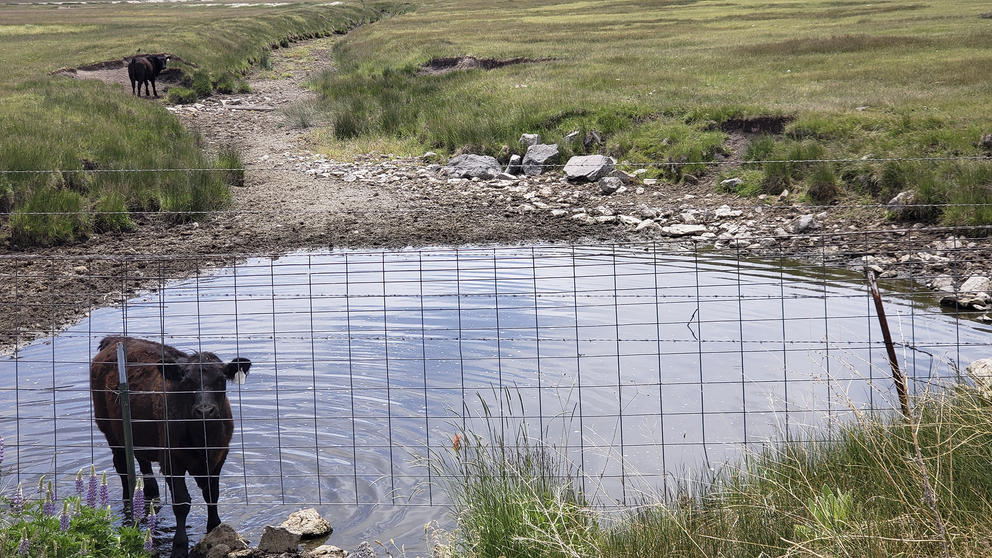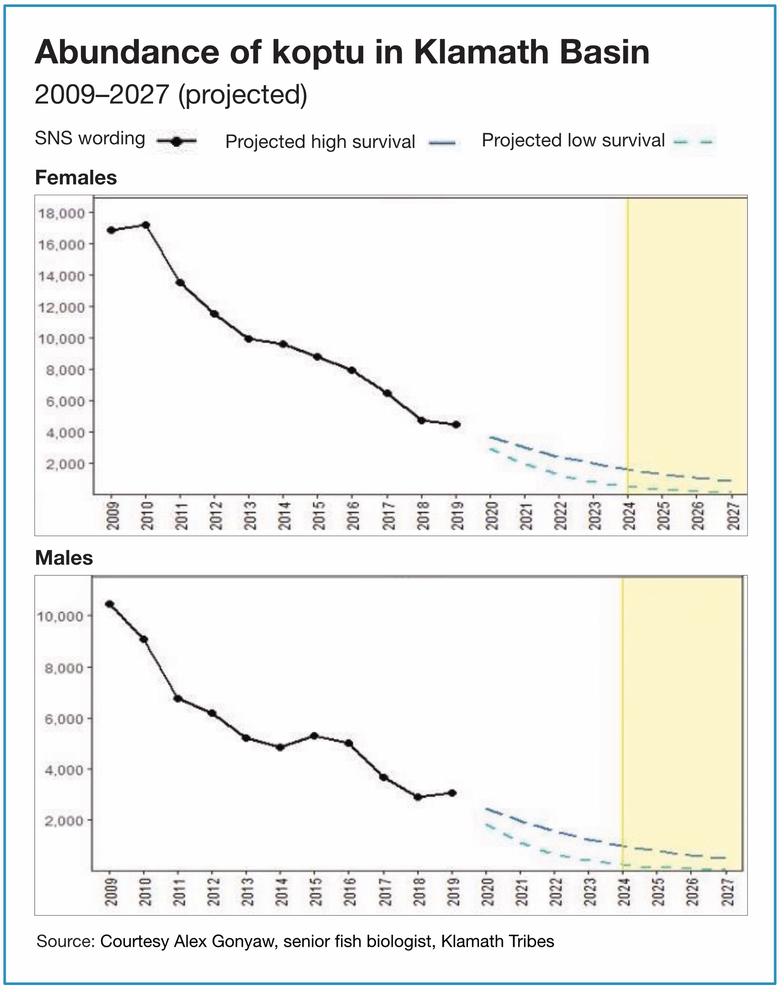“Historically, these fish were really incredibly abundant — we’re talking tens of millions of individuals,” said Alex Gonyaw, senior fisheries biologist of the Klamath Tribes. The tribes once relied heavily on the fish for subsistence and income.
Now, the suckers are on the brink of extinction.
During the past century, wetlands surrounding Upper Klamath Lake were converted to farmland, while waters from the basin were allocated to irrigators. The lake currently is used to store snowmelt water in the spring, and that can be released to farmers during the summer months. But with the wetlands gone, algae in the lake blooms and dies off each year in a cycle that makes the water too toxic for the juvenile fish to survive.
The c’waam (pronounced chwaam) and koptu — also called Lost River and short-nose suckers, respectively — were placed on the endangered species list in the late 1980s, but their populations have dwindled year after year. Gonyaw predicts the fish have only five or 10 more years left before they go extinct.
Water management in the basin might look different today if the Klamath Basin Restoration Agreement had been enacted. The agreement, 10 years in the making, brought together a diverse group of farmers, ranchers and tribal representatives to hash out a better water-sharing program. The agreement outlined a basinwide approach to water management that would address habitat restoration and fisheries in the Upper Klamath area, give irrigators more certainty about how much water they would receive each year and give priority to ecological recovery and tribal uses of the habitat and the fish.
The parties signed the agreement in 2010, but it required congressional authorization to be implemented. Legislation was introduced in 2011 by U.S. Sen. Jeff Merkley, a Democrat from Oregon, and U.S. Rep. Mike Thompson, a California Democrat. But momentum on the issue stalled amid political divisions between the Obama administration and congressional Republicans, and no action was taken on the authorization before the agreement expired.
In the absence of a basinwide water program, irrigators, tribes and federal managers have spent the past decade in and out of court battling for water, while the basin experiences what experts consider increasingly common water crises.
“The last 20 years have been dramatically different from the 80 or 90 that preceded that,” said Paul Simmons, executive director of the Klamath Water Users Association. “We’ve seen drier years in the last 10 years for sure. And the last two years have been terrible.”
The farmers in the Klamath won’t be getting any water this year, either. In May, the U.S. Bureau of Reclamation announced that drought in the region was so bad that it would not release water to irrigators. A handful of farmers and ranchers set up a protest camp at the Link Tree Dam in Klamath Falls. They have threatened to break open the headgates if federal water managers don’t help them. At least one irrigation district ignored the bureau’s decision and diverted water anyway.
The Bureau of Reclamation denied an interview request for this story and refused to answer questions related to water deliveries this year. The U.S. Fish and Wildlife Service, which manages recovery efforts for the c’waam and koptu suckers, also denied interview requests, citing the “sensitivities involved and the current climate” around the issue, and declined to answer any questions regarding management of the species.
The Klamath Basin could be a warning for how climate change might affect agricultural water rights in the West moving forward. Agriculture’s demands increasingly are out of sync with the hydrological cycles of the water systems they take water from. The symptoms of a warming planet — including higher temperatures, aridification and changes to precipitation patterns — are exacerbating this disconnect, driving wedges between water users and driving important species to extinction in the process.
Simmons said the lawsuits don’t actually help solve anything.
“Overall, the litigating we're doing and the wins and losses.... We’re not better off than we were two or five or 10 years ago,” Simmons said. “There’s a sort of increasing perception, up and down the river, that this ain't good. It's time. We need to try to take control of this and do better.”
Cattle ranches and farms now occupy much of the land that was once a vast system of wetlands surrounding Upper Klamath Lake. The destruction of the wetlands has contributed to water quality problems driving the c’waam and koptu, two species of suckers, to the brink of extinction. (Kendra Chamberlain/InvestigateWest)
A century of ecological degradation
Water scarcity in the Klamath Basin isn’t new. It's a high desert region, where dry, hot summers are the norm. It is also one of Oregon’s most productive agricultural areas. Private ranches and farms occupy lands that were once wetlands, the water from which diverted to feed crops and keep cows hydrated.
“The Klamath is sort of this remnant of the Great Basin in the last Ice Age,” said Steve Pedery, conservation director at the nonprofit Oregon Wild.
The basin once contained three large freshwater lakes, the Upper Klamath Lake, the Lower Klamath Lake and Tule Lake, and hundreds of thousands of acres of wetlands around them. Indigenous communities in the upper basin depended on fish and wildlife from these wetlands, and tribes down river on the Klamath depended on salmon runs.
“Teddy Roosevelt’s Bureau of Reclamation comes in and says, ‘Well [look at] these worthless swamps. Let’s put this land to good use.’ And they started draining those wetlands to convert them to farmland, and then they started draining the lakes,” Pedery said.
The degradation of the wetlands has created an annual algal bloom, which, toward the end of the summer, transforms Upper Klamath Lake into a body of warm, toxic water with no oxygen.
This cycle has devastated the c’waam and koptu populations over the past century. The past 30 years have been particularly bad. The two species have not had a successful “recruitment” — a term referring to the cycle in which juveniles return to the spawning grounds for their first reproductive year — since 1993. That means each adult c’waam and koptu is about 30 years old and quickly approaching the end of its natural life. Without a successful recruitment cohort to replace the surviving adult fish, the c’waam and koptu will be lost to extinction.
“We've been chipping away at that population for decades, and now we’re down to the last of the last of the adults,” said Gonyaw, the Kiamath Tribes fisheries biologist. “I get pretty fired up about this because I'm sitting here literally watching these fish go extinct on my watch.”
While adult suckers are able to survive the algal blooms, the juveniles are not, according to Summer Burdick, research fish biologist at the Western Fisheries Research Center with the U.S. Geological Survey. The USGS does most of the research on endangered suckers for the U.S. Fish and Wildlife Service, which manages the two species under the Endangered Species Act.
Degradation of the wetlands has left the lake filled with nutrients, which in turn feed algal blooms. The juveniles become stressed in this environment and succumb to pathogens that, under normal conditions, would not pose a serious threat to them, Burdick said.
Despite the federal government’s recovery efforts, “nothing much has really worked so far,” said Gonyaw. “We're down to 20,000 river c’waam, 5,000 spring c’waam, and about 3,400 little koptu, the short-nosed suckers.”
Impact on downriver salmon
The suckers aren’t the only fish in the Klamath suffering population declines in the wake of water management in the basin. A hundred miles downstream from the Upper Klamath Lake, water scarcity in the Klamath River has become a perennial problem for protected salmon species.
A century of water diversions and a string of hydroelectric dams in northern California have cut up and dammed hundreds of miles of cool waterways in the lower basin in which federally protected chinook and coho salmon spawn.
The Bureau of Reclamation is required to maintain minimum flows in the Klamath River to help flush the harmful parasites that thrive in the bathtub waters that the dams create. Each year, federal water managers must decide how much water to keep in the lake for the suckers and how much to send down the river to the salmon as a flushing flow. This year, there wasn’t enough water for a flushing flow to help the salmon combat the parasites. An estimated 60% to 70% of this year’s chinook salmon juveniles are expected to have died as a result.
That’s bad news for Northern California’s Yurok Tribe, for whom salmon have been integral to their way of life for centuries. Barry McCovey Jr., director of the Yurok Tribe Fisheries Department, which tracks chinook and coho runs, said the legacies of 20th century water management policies, coupled with rising temperatures and less snowpack, have created a “terrifying” situation for the basin.
“It’s not just fish runs that are suffering, the entire ecosystem is suffering,” McCovey said. “The ecosystem that is the Klamath Basin has been fractured and divided and diverted over the years. The ecosystem isn’t functioning how it evolved to function. You put too many straws in the cup, and things start to fail.”
Glen Spain, Northwest regional director of the Pacific Coast Federation of Fishermen's Association, agrees that the basin is running out of water.
“I often say that Klamath is a perfect example of a basin where everything that can go wrong with Western water law went wrong,” Spain said. “One of the problems is over appropriation [of water]. That is pervasive throughout the West. In the case of the Klamath, it’s very obvious that there's only a limited amount of water and there's way too much demand.”
The fisherman’s association is an industry group for commercial fishers in the Pacific. The organization has also become a major ally for the coho and chinook salmon. Spain said the situation in the basin is so bad that it’s not uncommon for the National Oceanic and Atmospheric Administration to limit or even shut down Pacific Coast salmon fishing due to poor salmon runs in the Klamath. The first time that occurred was in the 1980s. More recently, an unprecedented fish kill in 2002 led to a historic shutdown of commercial Pacific salmon fishing along the West Coast in 2006.
“Over 700 miles of coastline completely closed because of the declines in the Klamath,” Spain said. He estimated that the closure cost the industry hundreds of millions of dollars.
“It was a huge disaster that cemented an alliance between the commercial fishing industry and tribes on these issues, pressing for more water in the river and pressing for legitimate salmon recovery and restoration efforts in the whole basin,” Spain said. “People were no longer able to really categorize this as a farmers vs. fish kind of conflict. It was a farmers vs. fishermen, farmers vs. tribes conflict. It was jobs vs. jobs in one part of the community tied together with the other part, competing and conflicting.”
Looking for new basinwide solutions
A few years after the 2006 fishing shutdown, water rights holders and the tribes hammered out a sister plan to the Klamath Basin Restoration Agreement, the Klamath Hydroelectric Settlement Agreement.
While the restoration agreement dealt with habitat recovery and water rights, the hydroelectric settlement called for the removal of four dams on the Klamath River. A separate water rights agreement among stakeholders in the Upper Klamath Basin was negotiated a few years later, resolving some of the water rights issues in the Upper Klamath that the other two agreements left out.
“That meant dealing with water, dealing with restoration, dealing with the dams, dealing with water quality, dealing with community water rights, dealing with the loss of land for the Klamath Tribes, dealing with all these issues in the same big bag,” Spain said. “And we actually did it. We succeeded.”
The hydroelectric settlement is now in the process of being implemented. It’s considered the biggest dam removal project in U.S. history, and researchers agree the removals will offer significant habitat improvements to the struggling salmon. Spain hopes the four dams will be removed by 2023, after all the necessary federal permits are acquired.
The apparent success of the hydroelectric settlement for the river does not lessen the disappointment over the slow death of the Klamath restoration agreement. It was a huge blow to tribes and water-rights holders who worked so hard to find a solution.
“I wish it were still here with us,” said Simmons of the water users association. “It consumed about five years of my life, actually, working on that agreement. Our organization very much believes we need to get back to that kind of place and that kind of environment and that type of collaboration and interest-based negotiation and problem solving.”
Consensus among stakeholders is that the best solutions to address water scarcity in the area will be found in a basinwide water program like the ill-fated Klamath Basin Restoration Agreement. But any new restoration plan will need to be re-negotiated. Simmons said there’s growing appetite among stakeholders to take the issue on again.
“We just need to pull it out, look at it and see how we feel about what's there, what could you no longer live with or what needs to change, and don't make it more complicated than it is,” he said.
Still, reviving the agreement — and then implementing it — would take years. The c’waam and koptu may not last long enough to see any benefit. In the meantime, Gonyaw said, Klamath Tribes is preparing for the worst.
“Our efforts are to go out, collect larvae, bring them back and raise them in ponds really as just genetic conservation. We don’t want to get down to the last 500 fish and have a panic, scramble trying to preserve the genetics,” he said. “Given how high the mortality rate is, we think there will need to be hundreds and hundreds of thousands of fish needed to stem the loss. Nobody’s quite there yet.”






